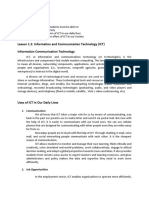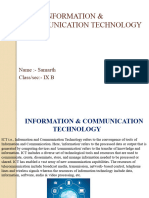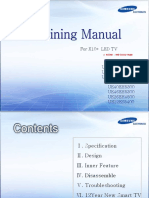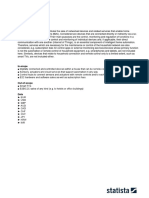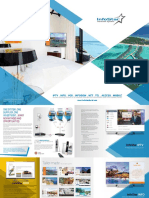INTRODUCTION TO ICT
For solutions to exercise
A. MULTIPLE CHOICE QUESTIONS
1. (a) TV
2. (c) Fast
3. (c) Amazon
4. (c) Flipkart
5. (a) Mobile
B. SUBJECTIVE TYPE QUESTIONS
Short Answer Questions
1. ICT helps store and manage data, facilitates communication via emails, helps in financial transactions,
schedules meetings, and improves productivity across departments using digital tools.
2. Online food ordering is made possible through websites and mobile apps, which are part of
Information and Communication Technology (ICT).
3. Some students prefer E-books instead of paper books as they are easy to store, portable, and can be
read on various digital devices.
4. Some popular government apps are BHIM, UMANG, Swachh Bharat Abhiyan App, and MyGov for
services like digital payments, sanitation, and citizen engagement.
5. Two popular websites for online classes are TutorVista.com and Itoltutor.com.
Long Answer Questions
1. Television is one of the earliest and most effective ICT tools. It serves as a powerful medium for
communication, entertainment, and education. Over the years, TV has evolved from black-and-white
screens to high-definition smart TVs with internet connectivity. It broadcasts news, serials, educational
programs, and live sports. Many educational channels now help students learn various concepts
visually. TV is especially useful for distance learning and awareness campaigns. It plays a major role in
shaping opinions and spreading information to remote areas. In today’s digital age, smart TVs also
allow app installations, streaming content, and accessing the internet—thus merging traditional media
with modern ICT applications.
2. Smartphones are one of the most widely used ICT tools today. They serve multiple purposes beyond
calling and texting. A smartphone allows users to access the internet, send emails, use social media, take
photographs, and even make digital payments. Educational apps, e-books, and online classes are easily
accessible on smartphones. It helps users connect through messaging apps like WhatsApp or video calling
platforms like Zoom. Smartphones support e-commerce, navigation (GPS), and healthcare apps. They
combine communication, computing, and multimedia functions into a single device, making them
essential for modern life. Their portability and multitasking features make them a powerful ICT tool in
both personal and professional life.
3. ICT plays a vital role in modern education by making learning more interactive and accessible. Tools
like smartboards, e-books, and educational apps have revolutionized classrooms. Online platforms such
as Byjus, Toppr, and Simplilearn offer video lessons, quizzes, and assignments that enhance
understanding. Students can access encyclopedias like Wikipedia and research materials anytime. ICT is
� especially helpful for students with special needs as assistive technologies enable better understanding.
During the pandemic, ICT enabled remote learning through video conferencing tools like Zoom and
Google Meet. It also helps teachers prepare presentations and share study materials quickly. Overall, ICT
improves the quality and reach of education.
4. ICT has transformed healthcare services by improving diagnosis, treatment, and patient care. Computers
are used in hospitals to manage inventory, patient records, and billing systems. Doctors use ICT for
scanning reports, conducting tests, and sharing diagnoses with other professionals. Telemedicine
allows remote consultation through video calls, which is helpful in rural areas. Health-monitoring apps
and wearable devices track vital signs like heart rate, sleep patterns, and blood pressure. ICT also
provides access to online databases and research on diseases, medicines, and treatments. In
emergencies, ICT tools can quickly share data and coordinate responses. Overall, ICT increases efficiency,
accuracy, and accessibility in healthcare.
5. A smartphone is a portable device mainly used for making calls, sending messages, and accessing apps.
It is small, fits in the pocket, and includes features like camera, GPS, and e-wallets. A tablet, on the other
hand, is larger in size and functions more like a small computer. It is mainly used for reading, watching
videos, browsing, and attending online classes. While both devices have touchscreens and support apps,
tablets offer a better visual experience for reading or media consumption. Smartphones are more
commonly used for quick tasks and communication, while tablets are preferred for tasks that need a
bigger screen like drawing or editing.





































